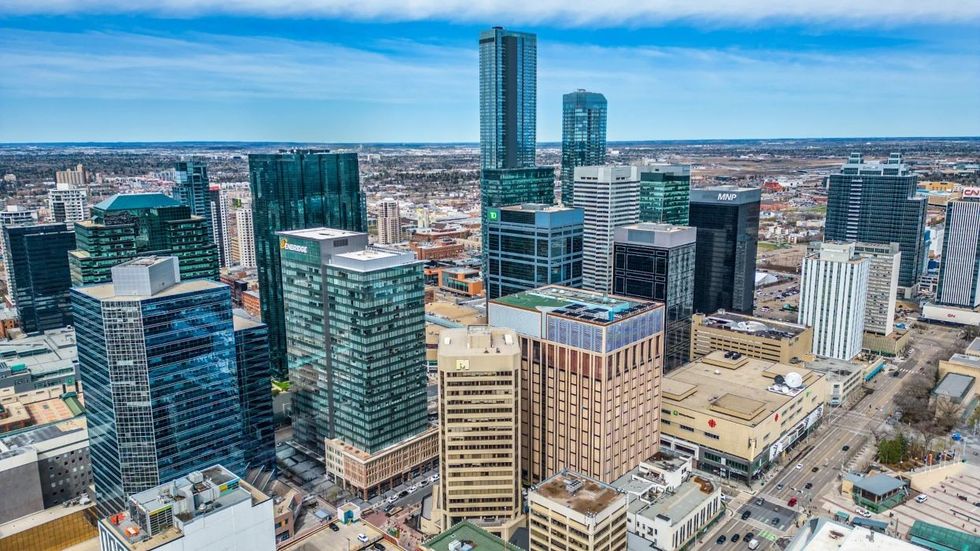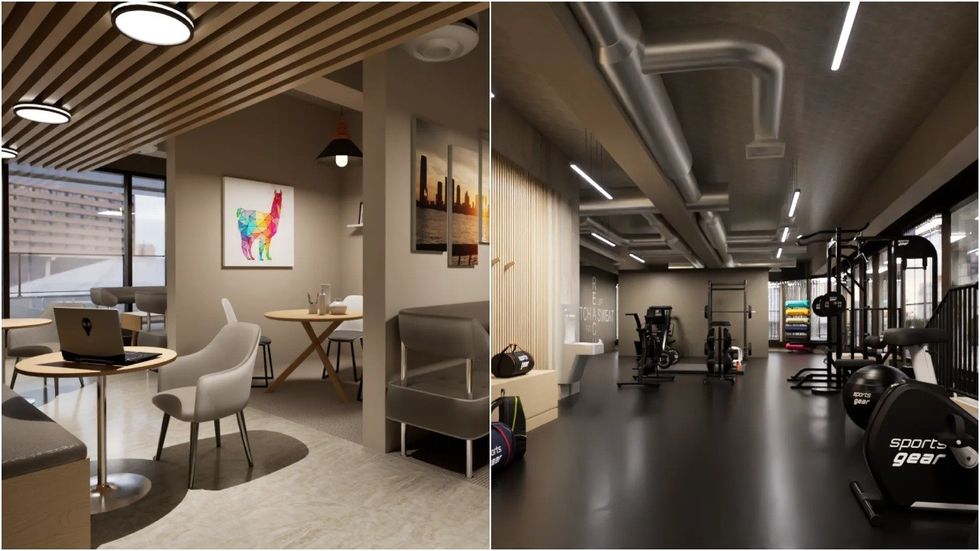Excitement in Edmonton peaked last year when it seemed like the City was on the verge of introducing a financial incentive program to faciliate office conversions like that of Calgary. That is no longer happening after the City was unable to find the funding for the program, but at least one office conversion project is nonetheless carrying on.
That project is the conversion of the Phipps McKinnon building at 10020 101A Avenue, along Rice Howard Way, in downtown Edmonton, which is set to be converted by Edmonton-based Josan Properties.
This office conversion project, however, is a bit different. Instead of converting all of the existing office space into residential space, only the office space on the lower levels will be converted while the office space on the upper levels will be retained. Specifically, Floors 11 through 19 will remain as office space and Floors 4 through 10 will undergo the conversion, with Josan Properties also converting the third floor into a high-end amenity space for both the office and residential occupants.
After its previous pension fund owner — CN Pension Fund, through Canapen Investments — decided to sell the Phipps McKinnon building along with the nearby Sherlock Holmes Pub and Sorrentino's restaurant properties, Josan Properties acquired the three properties in a deal brokered by CBRE, and did so with office conversion in mind.
The Asset
"It was really borne out of what happened to the office market during COVID," says President & CEO Raka Josan. "We started talking during COVID about all these office buildings that emptied out overnight and how there's likely some opportunity coming in the office market for investors like ourselves. So, we started poking around about a year ago to see if there was anything that would pique our interest and we eventually heard about the Phipps McKinnon building and said 'You know what, this is a great opportunity, it's an institutional asset, it's been managed very well by a pension fund, it's always been owned by an institution, and this is a rare opportunity for a private investor like ourselves."
Josan says his family-run company likes looking for opportunities to repurpose an asset or turn around an underperforming asset. Converting the Phipps McKinnon building — Josan Properties' first conversion project — is the latest instance of that.

The first thing a developer typically does when it comes to an office conversion is to conduct an analysis of whether their building is even suitable for conversion, as some are more suitable for conversion than others.
"This building kind of checked all the boxes for us," says Josan. "I would say the number one thing is the floorplate, which is just under 11,000 sq. ft. It's a square box, which is ideal. And our core-to-window depth is around 30 ft, so once you put a hallway in there, you've got that down to about 25 or 26 ft, which is really ideal for residential units, so you don't end up with long bowling alley-type units and you get nice square units."
The building, which was originally constructed in the 1970s, had also received a mechanical upgrade — new boilers, new chillers, among other things — in recent years thanks to its previous owner, which means Josan Properties won't have to do that.
The (Half) Conversion
So, why the decision to only convert half of the building?
From a financial perspective, it made more sense because there is no longer going to be any financial help from the City. When it seemed like the City was going to adopt an incentive program similar to Calgary, Josan envisioned a full conversion for Phipps McKinnon.
From a technical perspective, it also made sense because the building has split elevator banks. One of those elevator banks services the lower half of the building, while the other services the upper level, meaning the split is already baked into the building.

As to why Josan Properties chose to have office space atop residential, rather than residential atop office, which is more commonly seen, that was also a natural decision because a bulk of the office building's current occupancy is already located in the top half of the building. It was much simpler (and less costly) to relocate the lower half's four tenants to the upper half, compared to moving the upper half's 17 tenants down to the lower half.
Avison Young is handling the leasing for the remaining office space, with an asking lease rate of $16.00 per sq. ft per year.
The lower portion of the building, Floors 4 through 10, will then be converted into 91 rental homes.
The third floor will become a full amenity level for both office occupants and residential tenants, including a full fitness centre, sports simulator, yoga studio, and business centre, as well as private meeting rooms, a hosting lounge, and communal kitchen.
All in all, the project is expected to cost $22M and construction is expected to take 12 months after they receive their building permit, which is currently being reviewed by the City. Josan says the hope is that residential tenants will be able to move in by mid-to-late-Summer 2025.
Office Conversions In Edmonton
The lack of an office conversion incentive program, which many had hoped would be at least $75/sq. ft like Calgary's, came as a shock for many in the industry, considering how much sense it made and the momentum behind it.
"The general consensus of the real estate community here in Edmonton for the last year was, 'Yeah, of course the City will do something; this just makes too much sense,'" Josan says.
Regarding why the City was not able to provide the incentive program, Cory Wosnack, Managing Director of Avison Young's Edmonton office, says the City just had other priorities and he doesn't expect them to find the money for an incentive program in the next year or two.
However, Wosnack says there is still hope for other forms of incentives, such as property tax relief that allows owners to pay taxes on the value of the property from before it is converted, although he acknowledges that does not have the same appeal as a financial grant.
Previously, Wosnack had estimated that about 10 office buildings in downtown Edmonton were ripe for conversion with the right incentive program. Now, without the financial help, it's unclear whether any of those conversions will move forward, although Wosnack says some are currently being assessed."
"What we're seeing right now, in real time, is some off-market transactions that are in the works that are potentially putting these properties into the hands of investors that are looking very closely at conversion," Wosnack says. "We're going to see only a few. We will not see half a dozen or more that we could've seen with an incentive [program]."
Josan would have liked to see the incentive program — they budgeted an incentive of just $40/sq. ft — but it's not stopping them from moving forward with the project.
"We really believe in the theory of bringing people back to downtown and activating these buildings — making them usable 24/7 rather than just office hours," Josan says. "So we're moving forward despite not having an incentive."
- How Peoplefirst Developments Converted The Cornerstone Office Building ›
- How Peoplefirst Developments Decided to Convert Calgary's Petro Fina Building ›
- Gensler's Steven Paynter on His Office Building Conversion Algorithm ›
- A Changing Of The Guard Has Occurred In Edmonton's Office Market ›
- Guardian Office Building In Edmonton Under Receivership Listed For Sale ›
- Calgary Relaunches Office Conversion Incentive Program ›
- Edmonton Proposing $553M Action Plan To Revitalize Downtown Core ›
- Inside Calgary's First Office-To-Post-Secondary Conversion ›





















